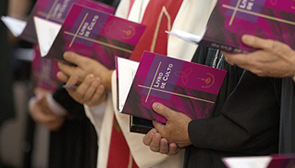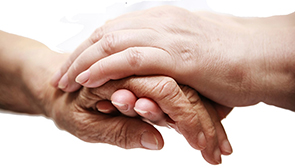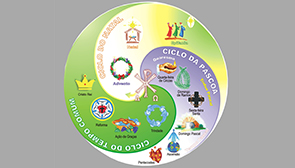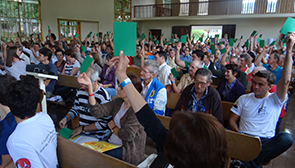 Pastor: Hanna Schramm (ILCH)
Pastor: Hanna Schramm (ILCH)
Iglesia Luterana de Chile.
Translation: Elisa Pérez Trejo (ILM)
Iglesia Luterana Mexicana
Healing of the bleeding woman or the woman who touched Jesus' robe
Mark 5, (24) 25-34 (Matthew 9,20-22; Luke 8,43-48)
This story tells of the healing of a woman who had a long history of suffering from her illness for which no cure had been found. In these months we live in anguish due to a disease that we still know little about and have trouble controlling. We are instructed to keep our distance and not touch each other. We are told to do the opposite of what this woman went through when she was healed. She passed through a crowd of people and touched Jesus.
I. The context of the story
The story of the healing of the bleeding woman is told by the three Synoptic Gospels. The most detailed version is found in the Gospel of Mark, so the reflection is based on this version. Mark like Luke, tell it within three stories of healing that describe increasingly complex cases. First, Jesus heals a man possessed by an impure spirit in Gerasa, in a non-Jewish land, returns by boat to Jewish land and two more spectacular healings take place: the resurrection of Jairus' daughter, and in between this story, when Jesus is found on the way to Jairu's house, the healing of the woman who suffered from hemorrhages. Meanwhile, in the first healing of the man from Gerasa, Jesus encourages this healing to be made public and also confronts the woman healed of hemorrhage by letting people around know what happened, trying to prevent the third and most impressive healing of the daughter of Jairus. Only the parents and three disciples are witnesses and he asks them to keep quiet about the girl's resurrection. This is in stark contrast to the large crowd that followed Jesus home. The healing of the demonized man happens by word. The healing of the bleeding woman happens, because she touches Jesus. The third healing happens with word and also because Jesus takes the hand of Jairus' daughter. The healing of the bleeding woman is a moment that delays the arrival of Jesus at Jairus´ house. Jesus takes the time to identify the woman and talk to her. When he is still talking with her, he hears the news about the death of Jairo's daughter. It seems that the story of the healing of the bleeding woman serves to further dramatize the situation that Jairus lives for his daughter.
II. The content and exegetical-literary observations.
In verse 24 it is reported that Jesus is going to the home of a synagogue chief, Jairus, his daughter is dying. They are accompanied by a large crowd that squeezes Jesus.
Verses 25 and 26 present the woman. We do not know her name, but her suffering is described in detail. It is 12 years that she has bleeding. (The daughter of Jairo that Jesus resurrects later is exactly 12 years old, about to start her life as a woman and having her first menstruation, her first flow of blood). In verse 26 it is said that she has suffered much. It is striking that suffering is related not to bleeding, but to doctors (upo pollon iatron, under many doctors). It is likely that the suffering is caused by the doctors themselves. It is also mentioned that she spent everything she had to be healed, but she could not be cured, on the contrary, her condition worsened. Thus it is implied that they took advantage of her by mentioning that she spent everything she had. This presentation describes a very desperate woman. Furthermore, although the text does not mention it directly, it must be marginalized as sterile and impure according to Jewish law (see Levitus 12 and 15). Loss of blood expresses loss of life and debilitation. It is a typical description of the previous situation of people that Jesus heals. The demonized man lived apart, broke chains, Jairus´ daughter seemed to be dead. All are cases in which the possibility of an improvement, of a healing is discarded.
Verse 27 describes the action of the woman. Emphasis is placed on her motivation. It is not very clear if she only listens at this moment, who Jesus is or if she knew about him before and now only the information of the presence of Jesus reaches her. It is striking that the motivation and immediate actions of women are described in just one sentence. Getting to touch Jesus must have been a great effort for the woman because of the crowd that surrounded Jesus. In an indirect way, something extraordinary is already described that anticipates something even more extraordinary, her healing: the woman manages to touch the robe of Jesus despite the crowd of people. In this way her great hope and the trust she places in Jesus is expressed. The woman approaches Jesus from behind. This tells us that she pretends not to be identified by Jesus and that her healing will not be discovered. I
n verse 28 the inner thought of the woman is manifested. Direct style is used. This phrase reveals the great faith and conviction of this woman. It seems like an annex that goes into depth and explains the action described above. The woman expresses that touching Jesus' robe will heal her. We do not know clearly what is the concept behind this conviction. The idea that Jesus has a power that heals and that this is also transmitted by touch?
Verse 29 tells us that the woman's wish is immediately fulfilled. It is interesting how it is described: In original Greek it says that the flow of blood is dried up. That something is dry does not normally indicate a very healthy state of health, but in this case it does. It is also interesting the way in which the woman realizes that she is healed is expressed. In the original Greek it is formulated: she felt in her body. It is not just a feeling, but she knew it clearly and with reason. Intellect and body are connected. The Greek word mastigos (mastids) means physical suffering rather than disease. The release of great discomfort is expressed.
Verse 30 illuminates everything that happened from Jesus' perspective. Again it is said that what happens in Jesus is immediately (As verse 29 begins with and immediately so verse 30.) In this way the author expresses that the connection between woman and Jesus happens immediately. Jesus realizes that he did something towards someone else. Although his body is not spoken directly, something happens that is more than intellectual. A force (dynamis) comes out of himself. Jesus is described as someone who carries the force that has a power to do things and that can be experienced. The term dynamis is also used to describe the power of God. This story is the first in which this term is mentioned and it is likely that this story serves to introduce the reader to how “dynamis” works. Here too it is something that Jesus captures with his intellect, he knows it, just like the woman. Immediately Jesus turns around and asks for the person who has touched him. It is curious, because it is not said that Jesus knows that someone touched him, but rather that an action was carried out from him, the departure of the force. With Jesus' question it is clear that the woman cannot prevent her action from being hidden. Jesus expresses his interest in having his power demonstrated and revealed to the people.
In verse 31 the disciples ask Jesus a rhetorical question, making their question ridiculous. In this way it is shown that Jesus is not referring to any unintentional touching or brushing. Jesus refers to a different way of touching.
Verse 32 informs us that Jesus searches with his eyes for the person who brought out his force, without taking any further action. In a context in which things happened quickly, it is a moment of slow motion to increase the tension and reach the climax of the story: the identification of the woman and the conversation between them.
Verse 33 describes the woman's state of anguish when she realized that her action did not go unnoticed. Not only is the woman said to be afraid, she is also trembling. She is probably trembling because of the possible reaction of Jesus, because as an impure woman she was forbidden to touch another person, but also because something extraordinary happened. This knowledge leads him to fall before Jesus and tell the whole truth. You can see the great respect that the woman has for Jesus. It is not told what this truth is according to the woman, but it speaks of the whole truth. So it is possible that the woman not only tells that she touched Jesus' robe, but also reveals the good news of her healing and in this way proclaims the power of Jesus, something that she was not intended to do with her acting. It is also possible that she told the reason for her action and her long history of suffering.
Only after the woman identifies with Jesus we know of his reaction in verse 34: Jesus calls her “daughter” who wants to express closeness and affection and explains that she was healed by her faith. He also sends her assuring her peace and healing from her illness.
The biblical text reveals nothing more about the woman's reaction. This is striking as we learned about her history of illness, her state of affliction and her anguish over the possible reaction of Jesus in detail. But Jesus is already on his way to another healing encounter in Jairus' house and for this reason we know nothing more about the woman. Thinking of the seriousness of the condition of Jairus's daughter, it is striking that Jesus took a long time to listen to the woman and reveal her power. Something that in itself was not so necessary for the healing of the woman, but that indicates that Jesus takes time for all the needs and to get to know people. Furthermore, this moment of delay generates an increase in the complication of the situation of the next miraculous action, where Jesus shows even greater capacities.
It is probable that this story about a miracle served in the first communities to call people to be interested in Jesus, want to know more and finally begin to believe in Jesus. These stories relate the positive experiences of specific people with Jesus.
III. Thematic
The text mentions several themes that invite us to do a reflection.
1. The human being does not have absolute control over the body
It tells us about a sick woman who cannot be cured by human knowledge and wisdom. It shows the limitation of human arrogance in her desire to dominate the body and in this case a female body. It also makes us wonder what to do when nothing seems to alleviate symptoms and discomfort and how to live with a chronic illness or a difficult-to-control disease like coronavirus.
2. Abuse of sick people and women
The abuse to which sick people can be exposed like this woman is reported and evidenced. She lost all her property. In addition, the text mentions that the suffering, which she lived, was due to the doctors, who did not give her adequate treatment and worsen her health. The place of her illness is a particularly sensitive part, where the power to give life is found. The question arises, what have doctors done in this sensitive part of a woman's body, which made her suffer so much. With what callousness and cruelty have they operated? It could also be suspected that there were forced healing attempts even against the woman's will, because hemorrhages were seen as something impure. The unsuccessful healing attempts of doctors relate the power and dominion that men had over women and the desire to control and change them, ignoring her suffering. It is worth mentioning that until today many women (40 to 50%) experience physical or psychological violence in the delivery assistance, where they are not consulted and explained interventions and their wishes are ignored.
3. The stigma of the bleeding woman
There are a taboo subject in society. A disease in the sexual organs. In general we do not like to talk about diseases and when it comes to such an intimate part less. In addition, the flow of blood is something that hides and that gives us modesty. It is something that causes disgust and rejection. Until today, women are stigmatized by menstruation, for associating it as something dirty. It is for the same reason that the woman wants to remain hidden before Jesus. The discomfort, weakness and pain to which women are exposed each month for a few days due to menstruation are ignored. And this adds to the effort of hiding this flow of blood with sanitary pads, tampons, etc. The purchase is an extra expense, save them and later throw away is something intimate and uncomfortable. For me it is a very liberating story on this subject. A woman who bleeds does not have to hide and has the right to be welcomed and treated with respect and dignity and to be considered in her needs.
4. Healing is a process of personal awareness
The text relates healing as a process of awareness of women. Healing is something that she registers in her body and consciously knows that it happened. In addition, later in the conversation with Jesus thye talk about this process. Healing is not only an act that others attest, it is also something that the affected person confirms and of which they are convinced regarding this there may be differences between a medical and scientific perception and personal perception. Furthermore, healing requires conscious work, as in the conversation between Jesus and the woman.
5. Healing is proclamation of the Gospel
Jesus identifies the healed woman. Her healing cannot be covered up. Healing is an act that manifests and evidences the will of God to do us good and give us life. The unclean and rejected woman inadvertently becomes a proclaimer of the gospel about Jesus.
6. True healing is a right for which we can fight
The woman is presented as a sick person who is fighting for a change in this situation. When she finds the right path, she does everything to take it despite the prohibitions and risks. Jesus' reaction confirms that she has all the freedom to search for what gives her true healing. No rule or law should prohibit or impede the healing of someone. In the current context of Covid 19 we have a different experience: Our right to freedom is restricted for a higher common good: to save the weakest people.
7. Healing happens in meeting and sharing
The story relates the healing of the woman to her touching the robe of Jesus. It is also related that an energy / force came out of Jesus. Healing has to do with meeting others and being in the presence of people who do well and give positive encouragement. People like Jesus who willingly share what makes others better and who take time for the one who suffers.
In these days of the pandemic we suffer from the lack of encounters, physical contact and sharing with each other, supporting and helping each other. And we are called to find ways to supply these ways of doing ourselves well
IV. Questions for reflection
1.
a) How do we deal with chronic diseases and illnesses that have no cure?
b) How can we accompany people who suffer from chronic diseases and illnesses that have no cure?
c) Is there another form of healing in a situation like this?
d) How have you felt in these times of Covid 19?
2.
a) Have you felt abused by the health system?
b) Have you had the experience that a doctor has not taken you seriously, has not been respectful to you?
c) Have you experienced violence during childbirth or any other medical intervention?
d) Have you felt helpless in the face of your illness or the illness suffered by a loved one? - Have you felt helpless in these days of Covid 19?
3.
a) Is menstruation a topic that is discussed in your environment?
b) Do you have people you can talk to about it?
c) Is there a respect for the bleeding woman and her needs in your environment?
d) Is there a protection space for women?
4.
a) In your context, are there instances of conversation about health problems?
b) How can we generate and open spaces in our communities for people suffering from a disease?
c) How should we talk to sick people?
5.
a) Have you experienced that illness and healing have intensified your faith?
b) Do you know of people who testify that illness and healing have strengthened their faith?
6.
a) What obstacles and difficulties do the sick in your context experience for their healing process?
b) Do you experience marginalization and abandonment of patients?
c) What does the Covid 19 disease teach us about solidarity towards the most vulnerable?
7.
a) What helps you when you are sick?
b) How can we help close people who are sick?
c) What is a favorable environment for a sick person to heal?




















